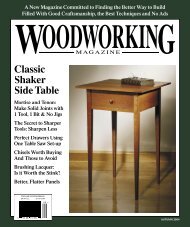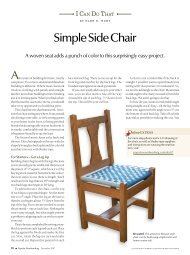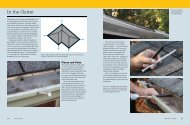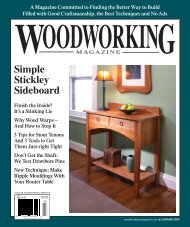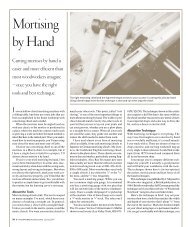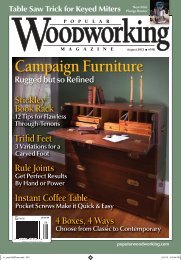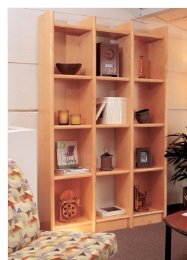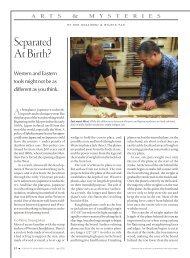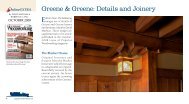ALL-WEATHER MORRIS CHAIR
ALL-WEATHER MORRIS CHAIR
ALL-WEATHER MORRIS CHAIR
Create successful ePaper yourself
Turn your PDF publications into a flip-book with our unique Google optimized e-Paper software.
All-Weather<br />
Morris chair<br />
10<br />
If you read the introduction to this book, then you<br />
know that this next project is special to me. It was<br />
the spark for all of my one-by furniture designs,<br />
and is still the most comfortable. The original All<br />
Weather Morris Chair was designed to fit a seat and<br />
back cushion. This made the chair comfortable, but<br />
if it had just rained and the cushions were wet, the<br />
bare chair wasn’t designed for sitting comfortably.<br />
The chair shown here is version 4.0 and I’ve<br />
modified it to work with, or without cushions, and<br />
I’ve adjusted some design and building techniques.<br />
I think it’s an excellent upgrade. Oh, did I mention<br />
the price Built from pine, each chair runs about<br />
$60 in materials, plus the cost of the hinge. A good<br />
coat of exterior paint and you’ve got a great chair<br />
for under $100.<br />
86 87
chapter 10<br />
all-weather morris chair<br />
21"<br />
2 1 ⁄2" 2 1 ⁄8"<br />
5 1 ⁄2"<br />
Q<br />
5 1 ⁄2"<br />
D<br />
22 3 ⁄4"<br />
D<br />
14 3 ⁄4" 10 1 ⁄2"<br />
A<br />
23 1 ⁄2"<br />
26 1 ⁄4"<br />
2"<br />
1 1 ⁄2<br />
8"<br />
22"<br />
A<br />
2 1 ⁄2" 1 1 ⁄2<br />
C<br />
C<br />
L<br />
K<br />
16 3 ⁄4"<br />
25 1 ⁄4"<br />
B<br />
N<br />
S<br />
19 3 ⁄4"<br />
3 1 ⁄2"<br />
7"<br />
2 1 ⁄2"<br />
all-weather morris chair • inches (millimeters)<br />
Reference<br />
Quantity<br />
part<br />
stock<br />
thickness<br />
width<br />
length<br />
(mm) (mm) (mm)<br />
A 4 front legs* pine 3 ⁄4 19 3 1 ⁄ 2 89 22 559<br />
B 4 rear legs* pine 3 ⁄4 19 3 1 ⁄ 2 89 20 508<br />
C 4 side strtchrs** pine 3 ⁄4 19 3 1 ⁄ 2 89 23 3 ⁄4 603<br />
D 2 f&b stretchers pine 3 ⁄4 19 3 1 ⁄ 2 89 26 1 ⁄4 667<br />
E 2 side slats* pine 3 ⁄4 19 2 1 ⁄ 2 64 14 1 ⁄ 2 368<br />
F 2 side slats* pine 3 ⁄4 19 2 1 ⁄ 2 64 14 1 ⁄8 359<br />
G 2 side slats* pine 3 ⁄4 19 2 1 ⁄ 2 64 13 3 ⁄4 349<br />
H 2 side slats* pine 3 ⁄4 19 2 1 ⁄ 2 64 13 1 ⁄ 2 343<br />
J 2 arms pine 3 ⁄4 19 5 1 ⁄ 2 140 35 889<br />
K 1 rear support pine 3 ⁄4 19 2 1 ⁄ 2 64 26 1 ⁄4 667<br />
L 2 side spprts*** pine 3 ⁄4 19 5 1 ⁄ 2 140 19 1 ⁄ 2 495<br />
M 6 seat slats pine 3 ⁄4 19 2 1 ⁄ 2 64 26 1 ⁄4 667<br />
N 2 back frame pine 3 ⁄4 19 2 1 ⁄ 2 64 30 762<br />
P 3 back frame pine 3 ⁄4 19 2 1 ⁄ 2 64 19 1 ⁄ 2 495<br />
Q 2 back plates pine 3 ⁄4 19 5 1 ⁄ 2 140 21 533<br />
R 5 back slats pine 3 ⁄4 19 2 1 ⁄ 2 64 19 483<br />
S 1 back suppport pine 3 ⁄4 19 2 1 ⁄ 2 64 31 787<br />
T 2 dowels hrdwd 1D 25 2 51<br />
* 5° angle, one end<br />
** 5° slope on top edge of two<br />
*** Cut to match template.<br />
You might notice that the<br />
lumber in the photos looks a<br />
little weird. It is. Half of it is over<br />
40 years old. In rehabbing our<br />
house, I pulled out some old<br />
pine closets. Rather than throw<br />
the boards away, I tucked them<br />
aside, and when this project<br />
came around, I knew I could be<br />
earth conscious and reuse them.<br />
Since the whole piece was getting<br />
painted, no one would be the<br />
wiser. I did cut all the pieces to<br />
standard home center sizes, so I<br />
wasn’t cheating.<br />
There are a lot of pieces to this<br />
chair, but if you go ahead and cut<br />
them all to length, assembly will<br />
move pretty quickly.<br />
Building the Legs<br />
Each of the legs is made of two<br />
pieces of wood screwed together<br />
length-wise to create a T-shape.<br />
35"<br />
2 1 ⁄2"<br />
23 3 ⁄4"<br />
J<br />
2 1 ⁄2" 8 3 ⁄4"<br />
25 1 ⁄4"<br />
1 1 ⁄2"<br />
1The T-shaped front and back<br />
legs have a 5° bevel at the top.<br />
It’s easiest to cut that bevel before<br />
assembly. With the four front- and<br />
rear-facing pieces cut to the length<br />
given in the cutting list, set the saw<br />
for a 5° bevel and trim one end of<br />
each piece.<br />
2 1 ⁄2"<br />
5 1 ⁄2" 22 1 ⁄2"<br />
3 1 ⁄2"<br />
33 1 ⁄2"<br />
1<br />
⁄2"<br />
88<br />
89
chapter 10<br />
all-weather morris chair<br />
But to give the chairs their backward<br />
slope, the tops of the legs<br />
are cut back at a 5° angle. This<br />
means the front legs (with the<br />
flat piece facing forward) need<br />
a 5° angle on the top edge of the<br />
front piece, across the thickness<br />
of the board. The leg of the T<br />
that fits behind the front piece,<br />
needs a 5° cut from the front-toback<br />
on the width of the board.<br />
This process is reversed on the<br />
two back legs, since the flat piece<br />
is to the rear of the leg. Take your<br />
time marking and identifying the<br />
angles before making the cuts<br />
with your miter saw.<br />
The chair is essentially<br />
screwed together. I used a countersink<br />
bit to drill clearance holes<br />
and recesses for wood plugs in<br />
one motion.<br />
Start by marking the center of<br />
each flat piece of the front and<br />
back legs. Drill the countersink<br />
holes and screw the legs together.<br />
2Transfer the bevel location from the four cut pieces to the side-facing<br />
pieces of the legs. Remember that the front and rear legs are mirror<br />
images of one another, with the shorter “leg” pair to the rear. The legs are<br />
shown above positioned as they will be, with the rear (shorter) set on the left.<br />
The L’s will become T’s when the horizontal pieces are screwed to the center<br />
of the vertical pieces.<br />
All four legs have the leg of the T centered on the flat of<br />
4 the T. Mark the center line for screws.<br />
Drill three or four countersunk holes in each<br />
5 leg flat.<br />
Making the sides<br />
To join the front and back legs<br />
to create left and right leg sets,<br />
mark up 7" on the outside of<br />
each leg. Make sure you have<br />
front and back pairs. Then screw<br />
the two lower side stretchers in<br />
place on the legs.<br />
The upper side stretchers<br />
will require a 5° slope on the top<br />
edge. Place an upper stretcher in<br />
position, flush with the top edge<br />
of the front leg, and make sure<br />
the space between the stretchers<br />
is even at front and back. Then<br />
make a mark at the leg heights at<br />
both the front and back ends of<br />
the upper stretcher.<br />
3After marking the bevel locations, cut the other four pieces<br />
on the flat.<br />
6Then screw the leg pairs together, flushing the bevel ends<br />
to form the T. Pilot drill and countersink to avoid splitting.<br />
The lower side stretchers are located up 7” from the<br />
7 bottom of each leg.<br />
90<br />
91
chapter 10<br />
all-weather morris chair<br />
Connect the two marks to<br />
create a straight line, then cut<br />
the angle with a jigsaw. Clean<br />
up the cut with a bench plane if<br />
necessary. Mark the other upper<br />
stretcher the same way, then cut<br />
the slope.<br />
Screw each upper stretcher in<br />
place on the outside of each leg,<br />
and you’re getting closer.<br />
To create the box of the chair,<br />
the front and back stretchers are<br />
screwed in place with the front<br />
stretcher located 10 1 ⁄2" up on the<br />
inside of the front legs. The back<br />
stretcher is located 7" up on the<br />
inside of the back legs.<br />
Side slats<br />
The next step is to attach the side<br />
slats. You’ll see that I’ve provided<br />
individual lengths for each slat in<br />
the cutting list. Each slat also gets<br />
a 5° angle cut on the top edge.<br />
I’ve found it easiest to mark the<br />
locations of the slats (spaced 1 3 ⁄8"<br />
apart, starting from the back of<br />
the front leg), then hold the slat<br />
in place and mark the angle on<br />
the top of each slat.<br />
Because I want each slat top<br />
flush to the top of the upper<br />
side stretcher, I cut the slats a<br />
little short, letting the bottom of<br />
the slat fit up slightly from the<br />
bottom edge of the lower side<br />
stretchers.<br />
Screw the slats in place with<br />
a single screw at top and bottom.<br />
I couldn’t countersink these<br />
screws because the two 3 ⁄4"-thick<br />
pieces don’t allow enough room<br />
to add a plug. If you want to hide<br />
the screws, then you will need to<br />
add wood putty and then sand it<br />
8Screw the side stretchers in place on the outside of<br />
the legs.<br />
9Space the upper side stretcher 8” above the lower stretcher, which<br />
should be even at the top edge with the top edge of the front leg.<br />
Connect your front and rear marks with a<br />
10 straight edge.<br />
Screw the upper stretchers in place to complete the<br />
12 leg sides.<br />
Jigsaw wide of your pencil mark to leave room<br />
11 for cleanup.<br />
The front and back stretchers are screwed in place to<br />
13 the front and back legs. Check for squareness where<br />
the stretchers meet the legs.<br />
92<br />
93
chapter 10<br />
all-weather morris chair<br />
1 7 ⁄8"<br />
Rear<br />
smooth. I just allowed the paint<br />
to hide the screw heads.<br />
I prefer to mark the slat lengths with each slat held<br />
14 in place.<br />
A single screw in the center of each slat (top and<br />
15 bottom) holds things comfortably in place.<br />
19 1 ⁄2"<br />
Side supports<br />
With the slats in place, I checked<br />
the pattern (shown at left) for<br />
the shape of each side seat support.<br />
Though the supports are<br />
cut from 1×6 boards, the only<br />
cuts necessary are on the two<br />
long edges. The short ends keep<br />
the “squared” cuts from cutting<br />
the 1×6’s to length. Transfer the<br />
pattern to your board and cut<br />
the side supports to shape with<br />
your jigsaw.<br />
Clean up the cut edges with a<br />
hand plane, then screw the supports<br />
in place on each side.<br />
One last piece to hold things<br />
together. The rear support is the<br />
piece that will support the back<br />
frame of the chair. It’s essentially<br />
a mount for the hinge. It’s<br />
screwed between the two rear<br />
legs, and tight up against the<br />
back end of the two seat side<br />
supports. This piece is screwed<br />
through the back legs, and<br />
through the back support into<br />
the ends of the side supports.<br />
The seat supports fit flush to the top of the front<br />
16 stretcher, and attach to the slats.<br />
At the rear of the seat support, a 1 x 3 is screwed in<br />
17 place between the two legs. Another screw from the<br />
rear holds the piece against the ends of the supports.<br />
Front<br />
Side Support Template<br />
3 1 ⁄2"<br />
Each square represents 1".<br />
more slats and arms<br />
We’re now ready to add the seat<br />
slats. This is pretty straightforward,<br />
with the slats spaced 1"<br />
apart. The front slat is notched<br />
7 ⁄8"-deep to fit around the front<br />
legs, and then is screwed in place<br />
to the front stretcher. This allows<br />
an overhang on the front slat.<br />
The front slat gets four screws,<br />
but all the others get two. A<br />
single screw on each end. I countersunk<br />
these holes for plugs.<br />
94 95
chapter 10<br />
all-weather morris chair<br />
The arms seem to bring<br />
things more than a step further<br />
somehow. One of the things that<br />
makes a Morris chair special is<br />
the ability to recline the back. To<br />
make this simple, three holes are<br />
drilled in the arms to offer three<br />
reclining positions. The holes are<br />
centered and at the back of each<br />
arm. The back support has two<br />
dowels attached that fit into the<br />
holes. This is also the reason why<br />
the arms extend so far beyond<br />
the back of the seat, and it’s one<br />
of the things that makes this<br />
chair a Morris! Clever folks! The<br />
arms should overhang the legs<br />
1" at the front and by 1 1 ⁄2" on the<br />
outside edges.<br />
After notching the front seat slat to fit around the legs, I used a roundover<br />
bit in my trim router to round the long edges of each slat. Less<br />
18<br />
chance of pinching something important.<br />
The rest of the seat slats are screwed into the seat<br />
20 supports on either side<br />
The two arms are also rounded with the router, Then<br />
21 screwed in place.<br />
building the Back<br />
The chair back is screwed together<br />
(countersink for plugs) with<br />
three horizontal cross members.<br />
The two at the top are spaced to<br />
fit a headrest plate, and the bottom<br />
to accommodate a matching<br />
plate (for symmetry). Both the<br />
plates should cover only half of<br />
the horizontal cross member,<br />
allowing you to nail or screw<br />
both the plates and the back slats<br />
to the same cross member.<br />
With the cross members positioned<br />
correctly, screw them in<br />
place through the back’s frame<br />
sides. Next screw the top and<br />
bottom plates in place.<br />
Lastly, to allow the proper<br />
swing of the back, clip the back<br />
corners of the seat at a 45° angle<br />
with your jigsaw.<br />
To complete the back, simply<br />
screw the slats in place on the<br />
frame. The two outside slats are<br />
The front slat is screwed in place on the<br />
19 front stretcher.<br />
Three cross members are screwed in place between<br />
22 the two frame sides.<br />
The top and bottom plates are then screwed to the<br />
23 front of the frame, lipping only half way over the two<br />
middle cross members.<br />
96<br />
97
chapter 10<br />
all-weather morris chair<br />
held flush to the sides of the back,<br />
with the other slats spaced evenly<br />
between. You’ll notice a difference<br />
between the illustrations<br />
and the picture. On the chair in<br />
the front photo I used three 3 1 ⁄2"-<br />
width slats, with two 2 1 ⁄2" slats<br />
between. Either design is fine, I<br />
just decided to play a bit with the<br />
spacing. Feel free to be creative<br />
with your chair!<br />
I rounded over the top edges<br />
of the back support (using my<br />
trim router), then drilled two<br />
1 ⁄4"-deep holes marked directly<br />
from the holes on the chair arms.<br />
By doing this rather than measuring,<br />
I’m assured a proper fit.<br />
Next, the two 2"-long pieces of<br />
1"-diameter dowels are screwed<br />
in place on the back support.<br />
A good final sanding to all<br />
surfaces and I was ready to paint.<br />
Any decent Krylon color will put<br />
a great finish on the chair. I used<br />
spray cans, and honestly, it took<br />
about six, so prepare for that.<br />
The last step is to mount the<br />
back to the chair. I’ve used a variety<br />
of hinges over the years, but<br />
I’ve found I get the best look and<br />
performance from a continuous,<br />
or piano, hinge.<br />
That’s it! You’re ready to kick<br />
back and enjoy the day.<br />
A 45-degree cut at the bottom of the back allows the back to<br />
24 swing to full-back position.<br />
After carefully marking the location for the dowels<br />
26 on the back support, I drill a shallow hole to protect<br />
the top of the dowel from the weather, and to locate the<br />
dowel accurately.<br />
The 2” chunk of dowel can then be glued (if you<br />
27 prefer) and/or screwed in place.<br />
The back slats are then screwed<br />
25 in place.<br />
After painting, the last step is to screw the continuous hinge to the back, then<br />
28 rest it in place on the chair and screw the other leaf of the hinge in place on the<br />
back seat suppot.<br />
98<br />
99



